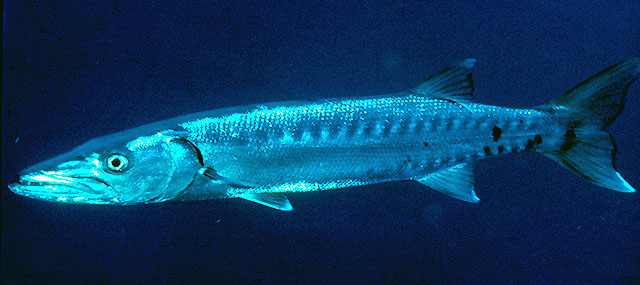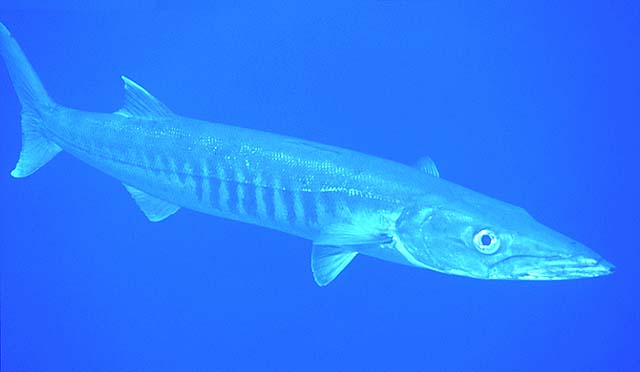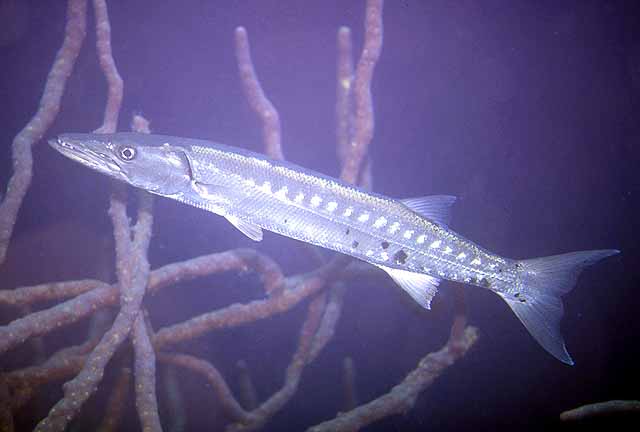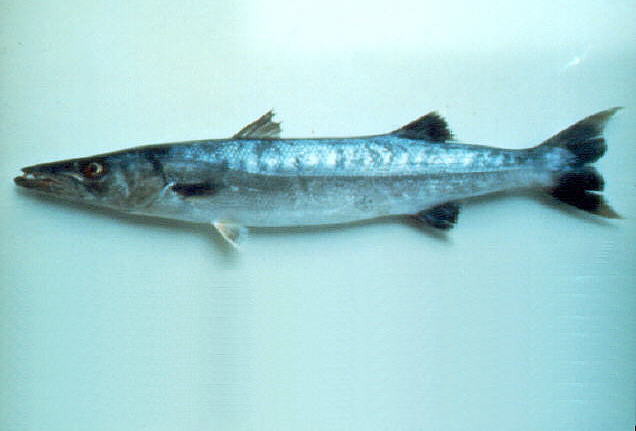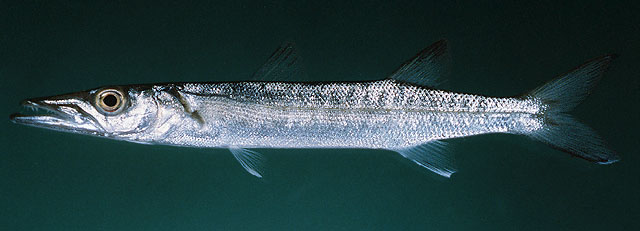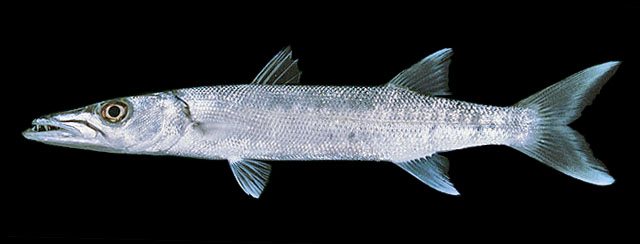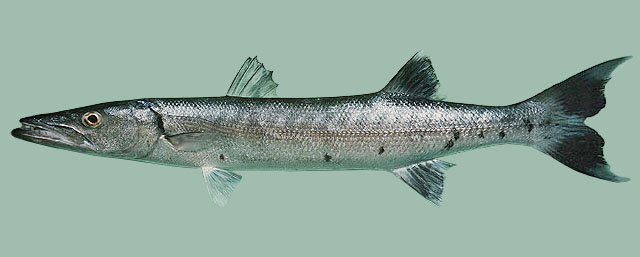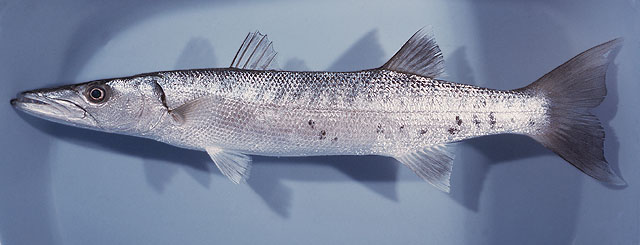Sphyraena
barracuda
(Edwards,
1771)
Great barracuda
View all media / Upload your photos and videos
Expand all
Classification / Names
Teleostei (teleosts) > Carangaria/misc (Various families in series Carangaria) >
Sphyraenidae (Barracudas)
Etymology: Sphyraena: Greek, sphyraina, -es = the name of a fish (Ref. 45335).
More on author:
Edwards.
Environment / milieu / depth range / climate zone / distribution range
Distribution
Indo-Pacific: Red Sea and east coast of Africa to Hawaii and the Marquesas and Tuamoto islands. Western Atlantic: Massachusetts (USA), Bermuda, and throughout the Caribbean Sea to Brazil (Ref. 9626). Eastern Atlantic: Sierra Leone, Côte d'Ivoire, Togo, Nigeria, Senegal (Ref. 6949), Mauritania (Ref. 5377), St. Paul's Rocks (Ref. 13121), and São Tomé Island (Ref. 34088).
Maps

Sphyraena barracuda / Native range
AquaMaps Data sources:
GBIF
OBIS
This map was computer-generated and has not yet been reviewed.

Sphyraena barracuda / Suitable habitat
AquaMaps Data sources:
GBIF
OBIS
This map was computer-generated and has not yet been reviewed.

Sphyraena barracuda / Point map
AquaMaps Data sources:
GBIF
OBIS
This map was computer-generated and has not yet been reviewed.

Sphyraena barracuda / Year 2050
AquaMaps Data sources:
GBIF
OBIS
This map was computer-generated and has not yet been reviewed.
Length at first maturity / Size / Weight / Age
Short description
Dorsal spines (total): 6; Dorsal soft rays (total): 9; Anal spines: 2; Anal soft rays: 8. This species is distinguished by the following characters: a large body, large eyes; body depth 6.0-8.2 in SL; teeth erect and contiguous; no gill rakers on first gill arch, instead upper and lower gill arch with rough platelets which lack distinct spines; origin of first dorsal fin at level of the rear base of the pelvic fins; caudal fin emarginate with a pair of large lobes at posterior margin, except young less than 50 cm TL which have a forked caudal fin. Colour of body silvery; many oblique dark bars on upper half of body that do not across lateral line; caudal fin black with white tips; juveniles with a series of large dark blotches irregularly arranged on sides of body (Ref. 9768, 90102).
Biology
Found predominantly at or near the surface (Ref. 6949, 48637). Juvenile occurs among mangroves, estuaries and shallow sheltered inner reef areas; adult occurs in a wide range of habitats from murky inner harbors to open seas. Diurnal and solitary, but can also be found in small aggregations. Feeds on fishes, cephalopods and sometimes on shrimps (Ref. 9626, 48637). Sold fresh. Utilized also dried or salted (Ref. 9987). Although this species is ciguatoxic elsewhere throughout its range, it has not been reported to be poisonous in the eastern Atlantic (Ref. 6949, 48637). Rarely attacks humans, usually with one quick, fierce strike, which, although serious, is rarely fatal. The world's record on hook and line is a 5.5-ft. fish taken in the Bahamas that weighed 103 lbs. (Ref. 13442). Caught by handline, set nets, and other fishing gear (Ref. 9768). Minimum depth reported taken from Ref. 128797
Main reference
Daget, J. 1986 Sphyraenidae. p. 350-351. In J. Daget, J.-P. Gosse and D.F.E. Thys van den Audenaerde (eds.) Check-list of the freshwater fishes of Africa (CLOFFA). ISNB, Brussels; MRAC, Tervuren; and ORSTOM, Paris. Vol. 2. (Ref. 4339)
IUCN Red List Status (Ref. 125652)
Least Concern (LC); date assessed: January 29 2013
CITES (Ref. 123416)
Not Evaluated
CMS (Ref. 116361)
Not Evaluated
Threat to humans
Traumatogenic (Ref. 4690)
More information
- Countries
- FAO areas
- Ecosystems
- Occurrences
- Introductions
- Stocks
- Ecology
- Diet
- Food items
- Food consumption
- Ration
- Common names
- Synonyms
- Metabolism
- Predators
- Ecotoxicology
- Reproduction
- Maturity
- Spawning
- Spawning aggregation
- Fecundity
- Eggs
- Egg development
- Age/Size
- Growth
- Length-weight
- Length-length
- Length-frequencies
- Morphometrics
- Morphology
- Larvae
- Larval dynamics
- Recruitment
- Abundance
- References
- Aquaculture
- Aquaculture profile
- Strains
- Genetics
- Allele frequencies
- Heritability
- Diseases
- Processing
- Mass conversion
- Vision
- Pictures
- Stamps, Coins Misc.
- Sounds
- Ciguatera
- Speed
- Swim. type
- Gill area
- Otoliths
- Brains
Estimates based on models
Preferred temperature (Ref. 123201): 21.7 - 28.9, mean 27.2 °C (based on 2020 cells).
Phylogenetic diversity index (Ref. 82804): PD50 = 0.5 [Uniqueness, from 0.5 = low to 2.0 = high].
Bayesian length-weight: a=0.00851 (0.00710 - 0.01021), b=2.93 (2.89 - 2.97), in cm total length, based on LWR estimates for this species (Ref. 93245).
Trophic level (Ref. 69278): 4.5 ±0.6 se; Based on diet studies.
Resilience (Ref. 120179): Low, minimum population doubling time 4.5 - 14 years (K=0.09-0.11; tm=2-4).
Prior r = 0.31, 95% CL = 0.20 - 0.46, Based on 2 data-limited stock assessments.
Fishing vulnerability (Ref. 59153): Very high vulnerability (79 of 100).
Climate vulnerability (Ref. 125649): Moderate to high vulnerability (52 of 100).
Price category (Ref. 80766): Medium; Questionable: based on ex-vessel price for species in this genus.
Nutrients (Ref. 124155): Calcium = 5.57 [2.60, 15.19] mg/100g; Iron = 0.229 [0.101, 0.480] mg/100g; Protein = 21.2 [19.3, 22.9] %; Omega3 = 0.124 [0.054, 0.274] g/100g; Selenium = 21.4 [8.5, 52.9] μg/100g; VitaminA = 18.1 [4.1, 117.9] μg/100g; Zinc = 0.298 [0.187, 0.511] mg/100g (wet weight);

